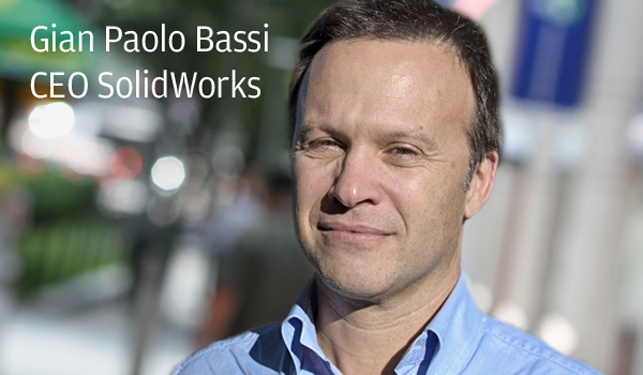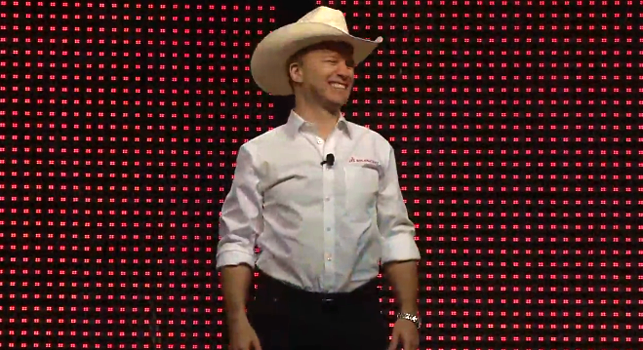
We caught up with new SolidWorks CEO Gian Paolo Bassi after SolidWorks World, and before his appearance at DEVELOP3D LIVE
While at SolidWorks World, we were lucky enough to wrestle new SolidWorks CEO Gian Paolo Bassi away from the crowds for a quick one-to one.
We chatted about his first SWW as CEO, the newly announced SolidWorks Industrial Design software (SW-ID), and his forthcoming appearance at DEVELOP3D LIVE in the UK.
“It’s going to be fun, yeah?!” opened GPB to this last topic. Given the interview that follows, we can guarantee that you’re not going to want to miss him on stage at DEVELOP3D LIVE on 26 March.
D3D: How has your first SolidWorks World as CEO gone?
GPB: The first day, before I went on stage it was pretty emotional because I went on stage facing a big audience (including the streaming – we went way over six thousand this year) and their expectations, and you want to be understood very clearly – you know, I have an accent! So sometimes things don’t come through very quickly!
We’ve not had a lot of time to prepare because the transition happened in mid-January
It is impactful, you don’t want to disappoint people, you want to speak close to their hearts. This is not difficult in principle, because I’ve been meeting those guys for many years, even before joining SolidWorks officially.
But then when you have to craft the message and you have a very limited amount of time… I like to talk, and when I do, and when I go to the user events it is a setting I like a lot. Now, on this stage, we have to adhear to a schedule, you can’t overrun – that was the toughest task for me!

Bassi having fun on stage addressing SolidWorks World 2015
Having been at SolidWorks for a while, and with users having seen you on stage before, has this made the transition easier?
There is this component of being a CEO where people at our company are looking into the future mostly. Our organisation is very established, there is nothing that needs to be changed in the core values.
So in a way, my job is easier; what is increasingly complex is in the technology landscape, and the need for us to find ways to always stay ahead of the curve and give our customers the tools that they need, before they even know they need them, because then it will be too late.
There is nothing to change in SolidWorks in terms of value and culture – the culture is amazing, actually.
We have a lot of people working to bring our products to the next level. There is a lot of work to do, [our users] understand this – we are very candid, very honest, we never oversell what we do, and this is what [users] appreciate.
With your transition to CEO, is the roadmap for the next few years already underway?
Yes. We wanted to be gasoline, hybrid and plug-in [an automotive analogy referring to SolidWorks’ CAD offerings being traditional, semi-cloud, and cloud, respectively].
We want to be the Toyota [does all three], not the Tesla [only plug-in].
Tesla is very cool, but Tesla is the newcomer, the start-up, and that for them is probably is the right thing to do. But we want to be like Toyota: we have millions of customers and we need to put them on the road at the right price now.
We have the customers that are ready for the hybrid, and customers that are ready for the plug-in – so our roadmap is very detailed for the next few years in achieving this.
I can tell you that with complete certainty that the desk product will be here to stay for a long time – 15-20 years with absolute certainty. We have 650,000 commercial seats, over 2.2 million education seats, so we added this year alone 55,000 commercial seats – it’s pretty staggering.
This is a momentum that is unstoppable, and evidently, our flagship products are on to something. We are super investing into reliability, performance and new features.
For instance, the next version of SolidWorks [standard edition] will have EPDM, and the price is exactly the same.
This year we will celebrate our twentieth anniversary with this big new introduction of EPDM for standard, because we need to help our customer more, and we have a lot of people on WorkGroup that can not easily migrate to easy and more powerful tools. So we think ‘fine… we will let you do that for free’.

Do you think that now there is more competition for SolidWorks now than there has ever been?
There is competition and we welcome it.
There’s competition from the traditional players: Autodesk is very aggressive in pursuing new categories, new values and new products; PTC seems to be attracted more by Internet of Things (which is by the way, extremely interesting), and of course Siemens.
Onshape we don’t know much about, so I’m looking forward to coming to DEVELOP3D LIVE to see what Jon Hirschtick will present – But I know one thing for sure, they will put on the market one heck of a product! Because the team is formidable.
Jon Hirschtick is one of my heroes by the way, let me make it very clear, even if he is now a competitor; but lets not forget he is the founder of SolidWorks, so we owe him a lot.
[Hirschtick] is talking about the need to embrace the internet as the next platform, I think it would be beneficial for us as well as we are on the same talking points. We believe that this is exactly where people need to go. The big difference between us and Onshape is that we have a pretty huge legacy.
Doing new things in a start-up is relatively easy, you just do it, you don’t have any constraints, you don’t have to take care of anybody – you have no customers, right?
For us it’s a totally different proposition, and arguably more and more difficult. I mean, it is a good place to be in, because nearly three million installed seats (we will surpass this number this year) is a nice place to be – don’t get me wrong! But this means that our responsibilities are very high, to understand that we are very close with our business community and our customers, and we do the right thing for them.
I use the tagline: ‘We want to embrace the future’, we cannot avoid that, but we need to respect our legacy.
SolidWorks Industrial Design (SW-ID) is approaching new customers and a new workflow, can you tell us why?
Not only SW-ID but Mechanical Conceptual as well, they’re all covering workflows that open up new opportunities for us because they’re new categories to us, but open up with new tools for our current customers.
Our current customers already do Industrial Design with SolidWorks as it is today, but they are telling us that there is not a tool designed for industrial design type of workflows, and we understand that.
For instance, there is no nice integration on the tool Industrial designers like the best – the bend.
Most importantly, industrial designers think very visually and totally in 3D, so for them a curve-based type of workflow, which is arguably what we have in SolidWorks, is not really perfect. Like sweeps and lofts and fillets – yes we cover all those, but it is not good enough. So the approach of a clay-like type of thing is exactly what they asked us to do.
Today if they want to create a swooping shape to conceptualise on a piece of paper, then they go on the computer with SolidWorks – it takes a lot of time.
We used technology created in Dassault Systèmes many years ago, so it is in fact not a new product – the technology itself has been proven in the industry for many years ad is used by top manufacturers – it is an industrial strength technology with our DNA in terms usability, price point, and those types of things.
Will there be more tailoring of new SolidWorks software for different industries?
Yeah, that is for sure, because Big Data is a trend that is unequivocal – there are billions of data that are being collected, but the problem is figuring out what the data is telling you.
We have technology to do that – [Dassault Systèmes] Exalead is one of the best search engines that can be tuned and tweaked, and integrated with our design technologies.
Many think that the problem of creating shapes is pretty much solved, I totally disagree by the way, but in addition to that we definitely needed to add in tools that can help you to innovate, not just create a shape.
The thinking that goes around creating a product is 10 per cent design and 90 per cent thinking and research. So for us it’s very important to have tools that can cover that 90 per cent. Quite frankly, even when you have created your new product, and when you design, sell and maintain it, the design phase is still a miniscule part of the lifecycle of a product.
There are probably ten-times more people that need to access and make use of 3D designs than engineers, like people that have to sell, people that have to maintain, marketers, customers, pre-sale, post-sale, there is a huge population of people that don’t need to author those things. But need to have access to them.
Our tools have been designed for mass production, if you think about that – so you spend quite a lot of time designing that perfect one thing, and reproduce it a gazillion times. Now it’s different – you want your product to be designed for you. So we need to have tools that can connect better to the consumer so that they can tell us how they want their products.
This is mass customisation. How do you do that? You cannot give SolidWorks as it is today to all the users in the world to create their ring or their car, right? So this is an interesting problem where we need to think different on how to make it happen.
[Where] 3D printing can create new materials, we need to invent new CADs – today the NURBs-based CADs, the history-based CADs, the PLM – I think the technologies are losing a little bit of interest, because when you 3D print you don’t need the precision of NURBs, because that is needed when you cut. But when you 3D print, that is less important.
Optimisation is a category we are investigating a lot [This is coming from the acquisition of Simpack].
We have a lot of technology where instead of designing a link verified for stress, we want to say, ‘ok, I need to connect these two pins with a link, but I don’t know the dimensions. I know the forces in advance, so tell me where the material should go. And the interesting thing is that 3D printing can do exactly what optimisation tells you to do, because they don’t care if it is straight or if it is swoopy.
We were the first to make stress analysis a tool for all, not just FEA PHDs!
It is our specialty: to encapsulate very powerful tools with the simplest possible user interface so that everyone can use them.
Catch up with all the action from DEVELOP3D’s blog from each day of SolidWorks World 2015, here and as it happened:
SolidWorks World 2015 – What we learned about the new generation of SolidWorks products
Day Two – Moon landings with SolidWorks; keynote from Dr Michio Kaku; encouraging female engineers







